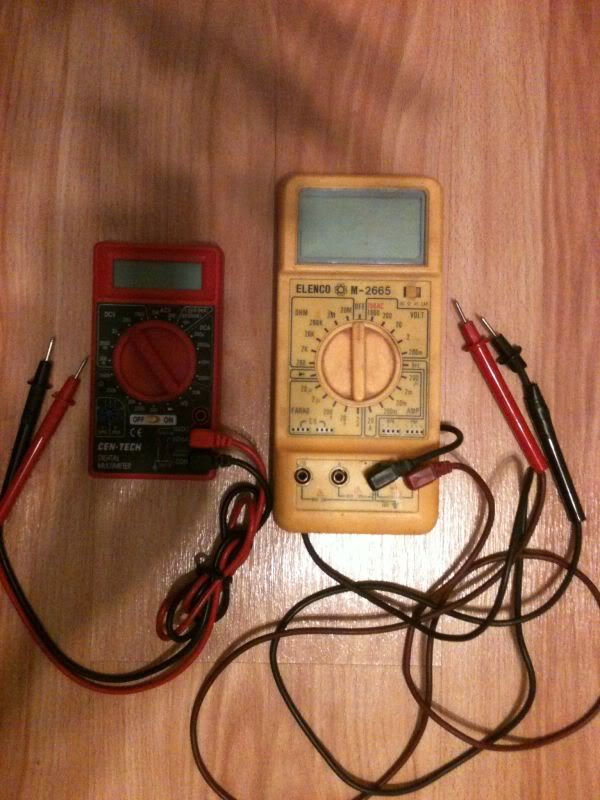Texas, how much resistance should pure copper wire have?
if thats the case, then i may just do the same. now i dont have to make any wires, and im good to go. you have a link to a cheap one that you own?
Don't get the Harbor Freight one! Sucks for currents, even with thick leads - see my post linked above.
-Garry
HKJ had some interesting things to say about this subject in a different thread.
He explained that his Fluke with good leads would read less than an inexpensive (but reasonably good) meter with good leads.
He showed a photo of the waveform and explained that becausee the wave form fluctuated cyclically, the true measurement of amperage should take that into account - something the Fluke actually did. On the other hand, the other meter read higher because it simply reported the level of the peaks in the curve - something to think about!
By the way, there was also a debate between PilotPTK and HKJ in that thread relating to the efficacy of clamp (no-touch) meters. I wish I had a link to the thread but you can do a search.
Regards,
Bob
I did and it works like charm! Thanks.
If you look on ebay there are some decent test leads, I look for a 10a or 20a rated, haven’t paid more than about $5, and at least half of them were OK, the bad ones refunded when I complained.
Welcome to the gang, Danglerb!



here’s the thread
I had because I’ve been thinking about buying a multimeter myself.
I think I’ve finally settle on buying a clamp meter and cottonpickers meter for lower amp readings.
My Elenco with thick gauge leads gives me results I trust. Like showing 1.4A from a light I put a 1.4A current regulated Nangj driver in. I also got the exact same current measurements as Foy in my E1320 modded UF2100 (Nangj driver at 3.5A -E1320 5 modes).
-Garry
Oldaker makes some very nice leads (in the USA) that sell for a reasonable price.
Harbor Freight has coupons for a free DMM w/ any purchase. That’s the only way I’d get one. If you get 5 new ones from them, you’ll get 5 measurements.
I think I’ve finally settle on buying a clamp meter and cottonpickers meter for lower amp readings.
Clamp meters are great, but nothing cheap will do DC well, only AC current. I have a Craftsman 82369 and I love it, but would not trust it to be accurate beyond ± 50 to 100ma. Something with decent DC clamp accuracy is going to be more like $200 or more.
When you are hooking up leads anyway I don’t see the point in using a clamp which will NEVER be as accurate as a serial wired meter.
Oldaker look like some nice leads, found a set on ebay for $25, PL 518-6. They have shrouded banana connections required on newer meters, but my $5 Chinese leads have worked fine so far.
Even high end dmm got diferent reading.I got 2 fluke a 79 series 2 also 88V and they dont Read the same.
Current measurements even from very good meters are less reliable than voltage or resistance measurements.
Use railway track as your conductors and keep the leads short and the results will be a bit more reliable.
Reliable current measurement is hard.
Current measurements even from very good meters are less reliable than voltage or resistance measurements. Use railway track as your conductors and keep the leads short and the results will be a bit more reliable. Reliable current measurement is hard.
Railway track would have a lot of resistance, wire may work better. :P
Current measurements even from very good meters are less reliable than voltage or resistance measurements. Use railway track as your conductors and keep the leads short and the results will be a bit more reliable. Reliable current measurement is hard.
Railway track would have a lot of resistance, wire may work better. :P
If you decide to use railway track, look both ways first.
Well, I received my KD C8 5 mode with LOP reflector (http://www.kaidomain.com/product/details.S009844) and tested it last night. This is only my second Chinese budget flashlight, and my first one over 150 lumens. I got a black tailcap and my driver looks exactly like the one shown in post #514 above. My lens was rattling so I did the “loosen the pill” trick to make it tighter. Since this is my first “high-powered” LED light I can’t compare it to another to estimate output (lumens).
For tailcap currents I used a cheap Harbor Freight DMM (one that sounds like many of you have) as well as an “Elenco” branded DMM that I built myself from an electronics kit back in 1994 in high school electronics vo-tech. Here are the meters:
At first I thought that I got an under-driven one like many of you which also seemed to agree with the specs of the driver - a max of 2A on high. Then I started testing with the second meter and swapping test leads and found some very interesting results. Lastly I used an 18” piece of scrap 14/2 AWG Romex as makeshift test leads. Battery is a brand new Trustfire flame 2400mAh 18650 which was freshly charged a few hours earlier. At the time of the readings the battery read 4.13v. Here are the readings:
H. F. Meter
Hi: 1.96A
Med: 0.96A
Low: 0.09AElenco Meter
Hi: 2.62A
Med: 1.29A
Low: 0.12AH.F. Meter w/14 AWG wire leads
Hi: 2.66A
Med: 1.26A
Low: 0.12AElenco w/14 AWG wire leads
Hi: 3.04A
Med: 1.44A
Low: 0.14AH. F. Meter w/ Elenco’s test leads
Hi: 2.31A
Med: 1.10A
Low: 0.10AIt appears to me that the cheap Harbor Freight meter is nearly worthless for current measurements. I think I also need to make my own test leads out of some good wire. (I’ll also order the <a href="http://www.dealextreme.com/p/multimeter-test-leads-probe-cables-90cm-33451">DX test leads</a> recommended by many.) Am I safe to assume that the highest current measurements I am getting are likely the most accurate? Why would the driver be listed as “2A” if it’s really putting out 3A? (If I don’t get much response here than I’ll post this as a separate thread.)Garry
At least on the HF I use, the difference is ~10% (1.9A to 2.1A on my DD test sample) to significantly more expensive RMS meter, each with their own leads (consistent with fluke leads across all the better meters), most of it down to the crappy leads on the HF. There’s just a much of a difference depending on just how much pressure I push on the leads against the tail-threads and cell, ~1.9 if only apply moderate instead of hard pressure.
Ironically the highest reading is from the HF with the “best” leads off a mediocre meter (Metex ME11), ~2.2A.
I suppose it’s possible HF sources from different places, but the two of them I have which came with different looking leads do perform the same.
Also, this is only for simpler resistive circuits, aka DD in our case. A current/power controlled driver (which controls its innards based on feedback) is going to do its job no matter the meter, which is rather the point.
Use railway track as your conductors and keep the leads short and the results will be a bit more reliable.
Reliable current measurement is hard.
The LED analyzer that I am developing (Any interest in a LED/Battery analyzer device?) uses Hall effect current sensors to measure current. The ACS758 high-capacity (50 amps and over) sensors have a 120 micro-ohm burden resistance… that’s in the railroad track range. The lower capacity ones (5-30 amps) have a 1.2 milliohm resistance.
You could build up a little gizmo with one of the sensors, a 9 volt battery, and a 5 volt regulator. The output of the sensor is a voltage that is proportional to the current flowing through it. You would measure that voltage, subtract the zero current offset value, and multiply the reading by the sensor’s amps per volt factor to get the current. There are several sellers on Ebay that sell the sensors mounted on a circuit board for a few dollars.
Or buy one of the LED analyzers when they are available… it has two current sensors (for battery current and LED current) and it does all the signal processing and boring math. With the 20 amp sensors, the reading noise/resolution is in the 1-2 milliamp range.
